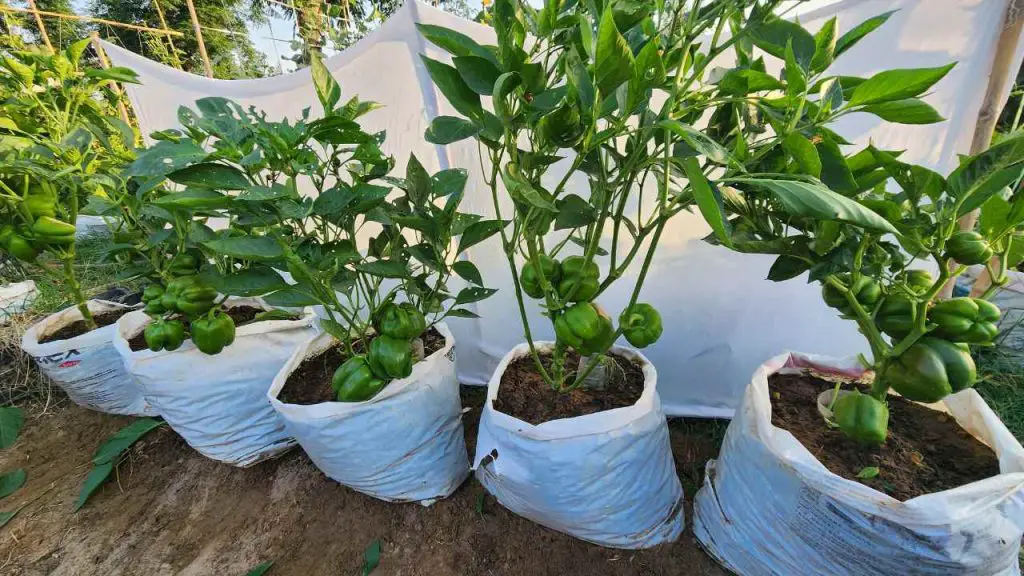Growing bell peppers from seeds is possible; however, because they thrive in warm environments, it is better to begin the process indoors approximately eight to ten weeks before the last frost. The appearance of seedlings might take anywhere from a few weeks to several months, so patience is vital.
Once more, conditions that are warmer are preferable, and if you use a heating pad or a heated propagator, you will achieve greater outcomes. Although it is possible to grow bell pepper seeds outside, there must be no possibility of the temperature being chilly.
Before planting seeds outside, it is recommended to wait two to three weeks after the last frost has occurred.
Best containers for growing bell peppers
If you want to avoid waterlogging, choose a container that has drainage holes at the bottom and has a diameter of at least 12 to 18 inches. Make sure that it is deep enough so that the pepper roots can develop without any difficulty.

When it comes to peppers, buckets with a capacity of five gallons are the ideal fit. You should select a container that has a diameter that is greater than one foot if you intend to plant more than one pepper in each pot. This is something that is feasible with non-bushy varieties of bell peppers and other types of peppers.
You should make sure that the container you purchase has a sufficient number of drainage holes. Peppers thrive in soil that is damp, but they do not do well in containers that are flooded with water. If needed, take a drill with a large bit to the bottom of your plastic or metal container to add extra drainage holes.
Soil Mixed with Organic Matter.
When it comes to growing bell peppers in pots, it is essential to acquire the appropriate potting mix. There are two distinct kinds of mixtures that can be made. Firstly, there is the seed starting mix that is used to plant the seeds. The second component is the potting mix that will be used to transplant the seedlings.
It is possible to utilize a soilless mix that is porous, light, and airy for the purpose of starting seeds. When the seeds begin to grow, the function of this medium is to supply hydration to the seeds in order to accelerate the process of germination and to create an anchoring that the roots can use.
To be successful at potting, you need soil that drains effectively. However, in order to enhance drainage and porosity, you should be sure to amend the soil with compost and manure before planting bell peppers in containers.
You can use the standard garden soil for this purpose. In the event that you are hesitant, you can simply purchase potting soil that is already prepared for use from garden centers.
Fertilize Twice a Month and Water Daily.
Once the temperature increases to the high temperatures that peppers prefer, it is highly probable that you will need to water your pots on a daily basis. To determine the level of moisture in the soil, you can simply insert your finger into the soil and feel its texture and dampness.
If you notice that the top inch or so of the soil in the pot is dry, it is a good indication that the plant is in need of water. In this case, it is recommended to give the pot a generous amount of water to ensure the plant’s hydration.
The ideal time to water your plants is in the morning, before the temperature rises and causes water to evaporate quickly. Additionally, by following this method, you can ensure that your peppers do not remain in damp soil for an extended period of time, preventing them from becoming waterlogged.
If you find yourself needing to water your plants often, you might want to think about adding a layer of mulch or straw to the pot. This can help to decrease the amount of water that evaporates from the soil.
Peppers need to be fertilized regularly because they produce fruit quickly. This statement is particularly applicable to peppers that are grown in pots. The reason for this is that when you water the plants, a significant amount of the nutrients present in the soil are washed away.
To make sure your peppers continue to produce, it is recommended to use a balanced vegetable fertilizer every two weeks. This will provide all the necessary nutrients for their growth and development.
Keep an Eye Out for Top-Heavy Growth.
Peppers are low-maintenance plants that don’t need any trimming or special attention. However, it’s important to keep an eye on the plants to prevent them from becoming too top-heavy. This is a frequent occurrence in bell peppers and other types of large peppers.
As the plant continues to produce fruit, the stem may gradually begin to bend. If this occurs, you can utilise a tomato cage or bamboo stake to provide support for the plant. Make sure to avoid tying the plant too tightly.
Keep Reading
- Ornamental Pepper Plant Care
- Can You Grow Tomatoes All Year Round In A Greenhouse?
- 20 Perennial Veggies You Can Plant Once And Harvest For Years
Harvest When Ripe
Peppers can be harvested at different stages of their growth, either when they are still green or when they have developed a more vibrant colour.
Spicy peppers tend to be less hot when they are in their less mature green fruit stage compared to when they are more mature and turn red or orange.
Similarly, the flavour of mild and sweet peppers tends to intensify as they change colour to yellow, red, or purple. The colour changes that your specific pepper goes through will vary depending on the type.
